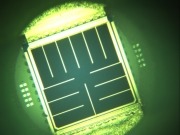
Dye-sensitized solar cells are one of the most promising types of solar cells in the market at present, but one of the main drawbacks of this kind of cell is the sheer cost of platinum, which is highly expensive at $1,500 dollars an ounce.
Platinum is a key ingredient of dye-sensitized cells. Fortunately only small amounts are needed but the cost is still significant. However, Yu Hang Hu, the Charles and Caroll McArthur Professor of Materials Science and Engineering at Michigan Technological University, has developed a new, inexpensive material that could replace platinum without losing efficiency.
3D graphene is a synthesized version of regular graphene having a unique 3D honeycomb-like structure instead of the usual two-dimensional form of carbon present in graphene. Hu and his colleagues have invented a novel approach to synthesizing graphene in which lithium oxide is combined with carbon monoxide in a chemical reaction that forms lithium carbonate (Li2CO3) in a honeycomb structure. The Li2CO3 helps to shape the graphene sheets and isolates them from each other, thus preventing the formation of garden-variety graphite. The particles can also be easily removed from 3D graphene using an acid.
The researchers found that the new form of graphene has excellent conductivity and high catalytic activity and this means it could also be used for energy storage and conversion. The team then replaced the platinum counter electrode in a dye-sensitized solar cell with one made of the 3D graphene, exposed the solar cell to sunshine and measured the result. They found that the cell with the 3D graphene counter electrode converted 7.8 percent of the sun's energy into electricity, nearly as much as the cell with the costly platinum.
"Synthesizing the 3D honeycomb graphene is neither expensive nor difficult" said Hu, "and making it into a counter electrode posed no special challenges."
The research has been funded by the American Chemical Society Petroleum Research Fund (PRF) and the National Science Foundation (NSF) and the results of the project have been published online in the International Edition of Angewandte Chemie.
Further information:

